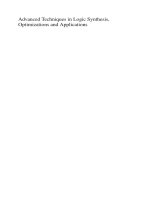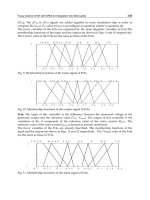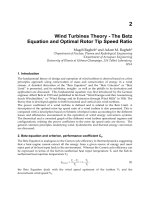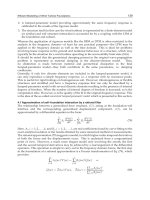Advanced techniques in RF power amplifier design
Bạn đang xem bản rút gọn của tài liệu. Xem và tải ngay bản đầy đủ của tài liệu tại đây (2.38 MB, 339 trang )
Advanced Techniques in RF Power
Amplifier Design
For a listing of recent titles in the Artech House Microwave Library,
turn to the back of this book.
Advanced Techniques in RF Power
Amplifier Design
Steve C. Cripps
Artech House
Boston London
www.artechhouse.com
Library of Congress Cataloging-in-Publication Data
Cripps, Steve C.
Advanced techniques in RF power amplifier design / Steve Cripps.
p. cm. (Artech House microwave library)
Includes bibliographical references and index.
ISBN 1-58053-282-9 (alk. paper)
1. Power amplifiers. 2. Amplifiers, Radio frequency. I. Title. II. Series.
TK7871.58.P6 C72 2002
621.38412dc21 2002016427
British Library Cataloguing in Publication Data
Cripps, Steve C.
Advanced techniques in RF power amplifier design. (Artech House
microwave library)
1. Power amplifiersDesign 2. Amplifiers, Radio frequency
I. Title
621.38412
ISBN 1-58053-282-9
Cover design by Gary Ragaglia
© 2002 ARTECH HOUSE, INC.
685 Canton Street
Norwood, MA 02062
All rights reserved. Printed and bound in the United States of America. No part of this book
may be reproduced or utilized in any form or by any means, electronic or mechanical, in-
cluding photocopying, recording, or by any information storage and retrieval system, with-
out permission in writing from the publisher.
All terms mentioned in this book that are known to be trademarks or service marks have
been appropriately capitalized. Artech House cannot attest to the accuracy of this informa-
tion. Use of a term in this book should not be regarded as affecting the validity of any trade-
mark or service mark.
International Standard Book Number: 1-58053-282-9
Library of Congress Catalog Card Number: 2002016427
10987654321
Contents
Preface xi
Acknowledgments xv
1 Class AB Amplifiers 1
1.1 Introduction 1
1.2 Classical Class AB Modes 2
1.3 Class AB: A Different Perspective 9
1.4 RF Bipolars: Vive La Difference 16
1.4.1 A Basic RF BJT Model 16
1.5 On Sweet Spots and IM Glitches 29
1.6 Conclusions 31
Reference 32
2 Doherty and Chireix 33
2.1 Introduction 33
2.2 The Doherty PA 34
2.2.1 Introduction and Formulation 34
v
2.2.2 The Classical Doherty Configuration 37
2.2.3 Variations on the Classical Configuration 42
2.2.4 Peaking Amplifier Configurations 49
2.2.5 Doherty PA Matching Topologies 52
2.2.6 The Multiple Doherty PA 56
2.2.7 Doherty PA Conclusions 56
2.3 The Chireix Outphasing PA 58
2.3.1 Introduction and Formulation 58
2.3.2 Discussion, Analysis, and Simulation 62
2.3.3 Variations 69
2.3.4 Chireix: Conclusions 71
References 72
3 Some Topics in PA Nonlinearity 73
3.1 Introduction 73
3.2 A Problem, a Solution, and Problems with the
Solution 74
3.3 Power Series, Volterra Series, and Polynomials 77
3.4 Two-Carrier Characterization 89
3.5 Memory and IM Asymmetry in RFPAs 94
3.6 PAs and Peak-to-Average Ratios 105
3.7 Conclusions 109
References 110
4 Feedback Techniques 111
4.1 Introduction 111
4.2 Feedback Techniques 114
4.3 Amplitude Envelope Feedback: Configuration and
Analysis 121
4.4 Vector Envelope Feedback 137
vi Advanced Techniques in RF Power Amplifier Design
4.5 Low Latency PA Design 140
4.6 Variations 146
4.7 Conclusions 150
References 151
5 Predistortion Techniques 153
5.1 Introduction 153
5.2 Third-Degree PA: Predistortion Analysis 156
5.3 PD Characteristic for General PA Model 163
5.4 Practical Realization of the Predistorter Function:
Introduction 177
5.5 Analog Predistorters 179
5.6 DSP Predistortion 187
5.7 Conclusions 194
References 195
6 Feedforward Power Amplifiers 197
6.1 Introduction 197
6.2 The Feedforward Loop 198
6.3 AM-PM Correction in the Feedforward Loop 204
6.4 Error Insertion Coupling 208
6.5 Third-Degree Analysis of the Generalized
Feedforward (FFW) Loop 216
6.5.1 Formulation and Analysis 216
6.5.2 Tracking Errors 222
6.5.3 Compression Adjustment 224
6.5.4 Third-Degree Analysis: Conclusions 228
6.6 Feedforward Loop Simulation 229
6.6.1 Effect of AM-PM in Main PA 231
6.6.2 Gain Compression Adjustment 233
Contents vii
6.6.3 EPR Change 233
6.6.4 Gain and Phase Tracking 235
6.6.5 Multicarrier Simulation 235
6.7 Feedforward Loop Efficiency Considerations 236
6.8 Adaption and Correction: Closing the Loop 241
6.9 Variations 249
6.9.1 The Double Feedforward Loop 249
6.9.2 A Feedforward-Enhanced Power Combiner 252
6.9.3 Budget FFW Systems 253
6.10 Conclusions 255
References 256
7 Microwave Power Amplifiers 257
7.1 Introduction 257
7.2 Broadband Microwave Power Amplifier Design 259
7.2.1 Introduction 259
7.2.2 Broadband Matching Using Network Synthesis 259
7.2.3 Balanced Amplifiers 270
7.2.4 Broadband Power Amplifier Design Issues 273
7.3 Microwave Circuits and MIC Techniques 280
7.3.1 Introduction 280
7.3.2 Substrate and Heatsink Materials 281
7.3.3 MIC Components and Structures 283
7.4 PA Design Using Prematched Modules 287
7.4.1 Introduction 287
7.4.2 Matching Issues for IMTs 287
7.4.3 Biasing Issues for IMTs 290
7.4.4 Power Combining of IMTs 291
7.5 Distributed Amplifiers 293
7.6 Conclusions 296
References 297
viii Advanced Techniques in RF Power Amplifier Design
Appendix 299
Notes 299
Selected Bibliography 300
Glossary 301
About the Author 305
Index 307
Contents ix
Preface
First of all, I should explain the title of this book. This is not really an
advanced book, but does cover topics which are generally of a less elemen-
tary, or tutorial, nature than my first book. In RF Power Amplifiers for Wire-
less Communications (RFPA, also published by Artech House), my overriding
goal was to present the subject material in a manner that is analytical but
hopefully still readable. Engineering literature has always bothered me. Both
books and technical journals seem to present everything couched in high-
level mathematics which the majority of practicing engineers cant under-
stand, or at best dont have the time or inclination to decipher. There seems
to be an emperors new clothes situation about it all; make the subject as
difficult as possible, frequently much more difficult than it needs to be, and
you are almost assured of pious nods of approval in higher places. Lower
places, where most of us operate, offer a less reverent reception, but seem to
accept the situation nevertheless. The odd paper maybe progresses as far as
the fax machine or the filing cabinet, but then rests in peace and gathers dust.
I am encouraged, and very grateful, for the positive response to my modest
but radical attempts to change this situation in RFPA, and proceed with this
volume in very much the same spirit.
The intention is that this book can be regarded as a sequel to the first,
but can also be read in isolation. It would be appropriate, therefore, to restate
briefly some of the philosophy and goals that carry over. First and foremost,
the spirit of a priori design methods remains paramount. Simulation tools are
getting better all the time, but the advantages of performing symbolic analy-
sis using simplified models before engaging in number crunching are still
xi
persuasive. Indeed, not being a particularly advanced mathematician myself
helps in that I feel it is easier to present readable symbolic analysis, rather
than the seemingly statutory unreadable stuff which abounds in the more
learned literature.
This book covers some new topics that barely got a mention in RFPA,
and takes some others which, although covered in the first book, deserve
more detailed treatment. Bipolar junction transistors (BJTs), for instance,
were barely mentioned in RFPA and with the advent of heterojunction bipo-
lar transistors (HBTs) and Silicon Germanium (SiGe) technology, things are
hotting up again for the BJT (pun somewhat intended). Chapter 1 revisits
the basics of Class AB operation, but with greater emphasis on BJT applica-
tions. Microwave power amplifier applications also get a chapter of their
own, Chapter 7, in which an attempt is made to pull together some of the
techniques which were developed in the 1970s and 1980s for higher fre-
quency (> 2 GHz) broadband amplifier design, and which could easily come
back on stream again as wireless communications run out of bandwidth at
the low end of the microwave spectrum.
Other chapters pick up on some of the things that were introduced in
RFPA, but not wrung out to some readers satisfaction. For all my enthusias-
tic promotion on the Doherty and Chireix techniques in RFPA, these admi-
rable inventions still appear to remain firmly rooted in history and vacuum
tube technology. So Chapter 2 revisits these topics regarding especially their
potential role in the modern scene. This includes a more generalized analysis
of the Doherty PA and some simulation results on practical implementa-
tions. The Chireix method continues to be a talking point and not much
else; Chapter 2 attempts to dig a little deeper into why this should be.
Chapter 3 takes up the theme of nonlinear effects in PAs, with a par-
ticular emphasis on the problem of asymmetrical IM distortion, its causes
and possible remedies. This chapter also has some tutorial material on the
behavioral modeling of PAs and attempts to show that there is still much use-
ful life left in polynomials and Volterra series modeling methods. In particu-
lar, the use of dynamic, rather than static, characterization methods are
discussed in relation to memory effects.
Linearization is, of course, an inescapable aspect of the modern PA
scene. Equally inescapable, it seems, is the growing impact of digital signal
processing (DSP) techniques in this area. Chapters 4, 5, and 6 cover the three
main linearization topics of feedback, predistortion, and feedforward. In
these chapters I find myself up against a burgeoning and already voluminous
literature, and also topics of current research which are engaging many
xii Advanced Techniques in RF Power Amplifier Design
thousands of engineers all over the world. I have therefore not attempted to
cover each topic in an exhaustive manner. I have basically applied my statu-
tory methods of symbolic analysis using simplified models, and I believe
come up with some useful results and observations. Most of the material in
Chapters 4, 5, and 6 represents, I believe, at least a different angle on the sub-
ject and as such is hopefully complementary to existing published accounts.
As a PA designer myself, one aspect which I have attempted to emphasize
throughout these three chapters is the need to redefine, and even to rethink,
the design of a PA which is to be used in any linearization system. This is an
aspect of the business which I feel has not been adequately considered, for
the logistical reason that PA linearization and PA design are frequently done
by different groups of people or different organizations.
I must make some comments on the patent situation in this field. This
book deals with a technology that has been the focus for much patent activity
over the years, and especially within the last decade or so. It seems that pat-
ents are now being issued not just for specific implementations, or variations
of well-established techniques, but in some cases for the well-established
techniques themselves. This is a big headache for any company wishing to
enter into the wireless communications PA business, and poses a problem for
an author as well. To generate a comprehensive, exhaustive list of relevant
patents would be a task comparable to writing a whole new book. Indeed,
perhaps it is a book someone should write. My policy has been to refrain
completely from citing individual patents as references, other than one or
two historical ones. This avoids any conflict where opposing factions may be
claiming priority and only one gets the citation. It does not, however, avoid
the possibility that I may be describing, or proposing, something that has
been patented sometime, by somebody. I have tried in general throughout
this book to make the reader aware of the need to perform patent searches
in this business if a commercial product is being contemplated. I have also
made specific comments about the likelihood of patents in certain focused
areas. In general, I have included a few ideas of my own in most chapters
(usually under the subheading Variations). These suggestions are my own
independent ideas and do not represent any commercial products of which I
am aware. They have not, however, been subjected to any patent search.
Unlike the previous book, which had substantial continuity from chap-
ter to chapter, this book treats the numerous topics in a manner which does
not always fall into a seamless narrative. Such is the nature of more
advanced topics. This is, primarily, a theoretical book; for the most part
I am analyzing how things work, and developing a priori methods for
Preface xiii
designing them. It is not a step-by-step guide on how to build RF power
amplifiers, advanced or otherwise. I believe that I am addressing topics which
RF designers, and especially those involved with RF power amplifiers, talk
about a lot amongst themselves. I therefore make no apologies for using more
words, and fewer equations, than in a conventional technical book.
xiv Advanced Techniques in RF Power Amplifier Design
Acknowledgments
This book represents, in a chronological sense, a time period in my own tech-
nical career which extends approximately back to my return from California,
to the greener and damper Blackdown Hills of Somerset in England, where I
have managed to keep working in the RFPA business, thanks mainly to the
sponsorship of several clients. Also, I continue to find the intelligent ques-
tions of my PA design training course attendees a great stimulus for keeping
on top of a rapidly developing technical area. So I must also acknowledge this
time, having omitted to mention them last time, the ongoing sponsorship I
have from CEI Europe, who continue to offer a first-class service and organi-
zation for training RF and communications professionals in Europe.
Steve C. Cripps
Somerset, England
May 2002
xv
1
Class AB Amplifiers
1.1 Introduction
The Class AB mode has been a focus for several generations of power ampli-
fier designers, and for good reasons. It is a classical compromise, offering
higher efficiency and cooler heatsinks than the linear and well-behaved Class
A mode, but incurring some increased nonlinear effects which can be toler-
ated, or even avoided, in some applications. The main goal in this chapter is
to invite PA designers and device technologists to break out of the classical
Class AB tunnel vision which seems to afflict a large proportion of their
numbers. For too long, we have been assuming that our radio frequency
power amplifier (RFPA) transistors obediently conduct precisely truncated
sinewaves when the quiescent bias is reduced below the Class A point,
regardless of the fact that an RF power device will typically have nowhere
near the switching speed to perform the task with the assumed precision. The
irony of this is that the revered classical theory, summarized in Section 1.2,
actually makes some dire predictions about the linearity of a device operated
in this manner, and it is the sharpness of the cutoff or truncation process that
causes some of the damage. Decades of practical experience with RFPAs of
all kinds have shown that things generally work out better than the theory
predicts, as far as linearity is concerned, which has relegated the credibility of
the theory. For this reason, and others, flagrantly empirical methods are still
used to design RFPAs, in defiance of modern trends.
Section 1.3 attempts to reconcile some of the apparent conflict between
observation and theory, showing that an ideal device with a realizable
1
characteristic can be prescribed to allow linear operation along with near clas-
sical efficiency. Section 1.4 discusses the RF bipolar and its radically different
formulation for reaching the same goal of linearity combined with high-
efficiency operation. The RF bipolar emerges from this analysis, taking full
account of the discussion in Section 1.3, in a surprisingly favorable light. Sec-
tion 1.5 returns to the field effect transistor (FET) as a Class AB device, and
the extent to which existing devices can fortuitously exhibit some of the line-
arization possibilities discussed in Section 1.3.
1.2 Classical Class AB Modes
This analysis should need no introduction, and what follows is largely a sum-
mary of a more detailed treatment in RFPA, but with some extensions into
the possibilities offered by dynamically varying RF loads. Figure 1.1 shows
an idealized RF device, having a linear transconductive region terminated by
a sharply defined cutoff point. The device is assumed to be entirely transcon-
ductive, that is to say, the output current has no dependency on the output
voltage provided this voltage is maintained above the turn-on, or knee
value, V
k
. The analysis will further make the approximation that V
k
is
2 Advanced Techniques in RF Power Amplifier Design
0 0.5
0
1.0
I
max
/2
I
max
Drain
current
Gate voltage (normalized)
Cutoff
region
Saturation
region
Quasi-linear
region
Figure 1.1 Ideal transconductive device transfer characteristic.
negligible in comparison to the dc supply voltage, in other words, zero. This
approximation is conspicuously unreal, and needs immediate addressing if
the voltage is anything other than sinusoidal, but is commonplace in elemen-
tary textbooks. Figure 1.2 shows the classical circuit schematic for Class AB
operation. The device is biased to a quiescent point which is somewhere in
the region between the cutoff point and the Class A bias point. The input
drive level is adjusted so that the current swings between zero and I
max
, I
max
Class AB Amplifiers 3
v
DS
v
IN
i
D
v
DS
V
dc
v
IN
v
OUT
R
L
dc blocking cap
Hi-Q "tank" (@ )f
0
RF "choke"
i
D
ZRjf
Zff
LL
L
()
0 (2 ,3 , etc.)
=+
=
0
0
00
i
1
iii
234
,,,
etc.
Gate voltage
Drain current
Drain voltage
V
o
V
o
V
t
V
q
I
max
I
dc
0
2p
3p
4p
p
0
wt
a/2
Figure 1.2 Class AB amplifier: schematic and waveforms.
being a predetermined maximum useable current, based on saturation or
thermal restrictions.
The resulting current waveforms take the form of asymmetrically trun-
cated sinewaves, the zero current region corresponding to the swings of input
voltage below the cutoff point. These current waveforms clearly have high
harmonic content. The key circuit element in a Class AB amplifier is the har-
monic short placed across the device which prevents any harmonic voltage
from being generated at the output. Such a circuit element could be realized,
as shown in Figure 1.2, using a parallel shunt resonator having a resonant fre-
quency at the fundamental. In principle the capacitor could have an arbitrar-
ily high value, sufficient to short out all harmonic current whilst allowing the
fundamental component only to flow into the resistive load. So the final out-
put voltage will approximate to a sinewave whose amplitude will be a func-
tion of the drive level and the chosen value of the load resistor. In practice the
load resistor value will be chosen such that at the maximum anticipated drive
level, the voltage swing will use the full available range, approximated in this
case to an amplitude equal to the dc supply. For the purposes of this analysis,
the maximum drive level will be assumed to be that level which causes a peak
current of I
max
.
Some simple Fourier analysis [1] shows that the efficiency, defined here
as the RF output divided by the dc supply, increases sharply as the quiescent
bias level is reduced, and the so-called conduction angle drops (Figure 1.3).
Not only does this apply to the efficiency at the designated maximum drive
level, but the efficiency in the backed-off drive condition also increases,
especially in relation to the Class A values (Figure 1.4). What is less familiar
is the plot of linearity in the Class AB region, shown in Figure 1.5. The
process of sharp truncation of the input sinusoidal signal unfortunately gen-
erates some less desirable effects; odd degree distortion is part of the process
and gain compression is clearly visible anywhere in the Class AB region. This
gain compression comes from a different, and additional, source than the
gain compression encountered when a Class A amplifier, for example, is
driven into saturation. Saturation effects are primarily caused by the clipping
of the RF voltage on the supply rails. The class AB nonlinearity in Figure 1.5
represents an additional cause of distortion which will be evident at drive lev-
els much lower than those required to cause voltage clipping. This form of
distortion is particularly undesirable in RF communications applications,
where signals have amplitude modulation and stringent specifications on
spectral spreading.
The Class B condition, corresponding to a zero level of quiescent bias,
is worthy of special comment. This case corresponds to a current waveform
4 Advanced Techniques in RF Power Amplifier Design
Class AB Amplifiers 5
0
2pp
Conduction angle
ABCAB
(Class)
0
+5dB
100%
−5dB
0%
RF power (dB)
Efficiency
RF power (dB)
Figure 1.3 Reduced conduction angle modes, power and efficiency at maximum drive
level.
100
50
0
−5dB−10 dB P
max
Efficiency (%)
Output power backoff (dB)
I
q
= 0.5 (Class A)
I
q
= 0 (Class B)
I
q
= 0.25
I
q
= 0.1
Figure 1.4 Efficiency as a function of input drive backoff (PBO) and Class AB quies-
cent current (I
q
) setting.
which, within the current set of idealizing assumptions, is a perfectly half-
wave rectified sinewave. Such a waveform contains only even harmonics, and
in the absence of damaging odd degree effects, the backed-off response in
Figure 1.5 shows a return to linear amplification. In practice, such a desirable
situation is substantially spoiled by the quirky, or at best unpredictable,
behavior of a given device so close to its cutoff point. It is frequently found,
usually empirically, that a bias point can be located some way short of the
cutoff point where linearity and efficiency have a quite well-defined opti-
mum. Such sweet spots are part of the folklore of RFPA design, and some
aspects of this subject will be discussed in more detail in Section 1.3.
One additional aspect of Class AB operation which requires further
consideration is the issue of drive level and power gain. It is clear from Figure
1.2 that as the quiescent bias point is moved further towards the cutoff point,
a correspondingly higher drive voltage is required in order to maintain a peak
current of I
max
. In many cases, especially in higher RF or microwave applica-
tions, the gain from a PA output stage is a hard-earned and critical element
in the overall system efficiency and cost. In moving the bias point from the
Class A (I
max
/2) point to the Class B (zero bias) point, an increase of drive
6 Advanced Techniques in RF Power Amplifier Design
Input power (2 dB/div)
Output power
(2 dB/div)
P
lin
V
q
= 0.5 (Class A)
0.25
0.15
0.05
V
q
= 0 (Class B)
Figure 1.5 Class AB gain characteristics.
level of a factor of two is required in order to maintain a peak current of I
max
.
This corresponds to an increase of 6 dB in drive level, and this is equally a
reduction in the power gain of the device. It is common practice to compro-
mise this problem by operating RF power devices at some lower level than
I
max
, in order to preserve efficient operation at higher power gain. The process
is illustrated in Figure 1.6 for a Class B condition. If, for example, the drive
level is increased only 3 dB from the Class A level, the current peaks, in a zero
bias condition, will only reach
I
max
/2
. This reduction in maximum linear
power can be offset by increasing the value of the fundamental load resistor
by the same ratio of
2
. The result, shown in the second set of waveforms in
Figure 1.6, shows only a 1.5-dB reduction in power at the available maxi-
mum drive, compared to the fully driven case. Significantly, however, the
efficiency in the underdriven case returns to the original value of 78.5%.
This concept of underdrive can be extended to more general Class
AB cases, although in the Class AB region the efficiency will not return to the
Class AB Amplifiers 7
Figure 1.6 Class B operation: Fully driven condition gives the same power as Class A
(0 dB) but requires a 6-dB higher input drive. Underdriven condition (3-dB
underdrive case shown) can still give full Class B efficiency if load resistor is
adjusted to give maximum voltage swing.
fully driven value due to the effective increase of conduction angle caused by
drive reduction. Another extension of the concept is to consider the possibil-
ity of an RF load resistor whose value changes dynamically with the input
signal level. Such an arrangement forms one element of the Doherty PA
which will be discussed in more detail in Chapter 2. It is, however, worthy of
analysis in its own right, on the understanding that it does not at this stage
constitute a full Doherty implementation.
Suppose that, by some means or other, the value of the load resistor is
caused to vary in inverse proportion to the signal amplitude v
s
,
RRv
Los
= /
so that as the fundamental component of current, I
1
, increases from zero to
I
max
/2, the fundamental output voltage amplitude remains constant at
v
R
v
I
vV
o
o
s
s
dc
=
=
max
2
where
I
I
v
s1
2
=
max
making the usual assumption of a perfect harmonic short, and a device knee
voltage which is negligible compared to the dc supply, V
dc
.
The fundamental output power is therefore
P
V
I
v
o
dc
s
=
22
max
(1.1a)
which is unusual in that the output power is now proportional to input volt-
age amplitude, rather than input power.
The efficiency is given by
h
pp
=
=
VvI
V
I
v
s
dc
s
dc
max
max
22 4
(1.1b)
Equation (1.1b) is an interesting result, the efficiency being independent of
the signal drive level. Given that the two central issues in modern PA design
8 Advanced Techniques in RF Power Amplifier Design
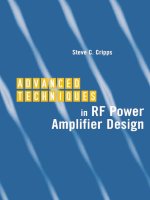
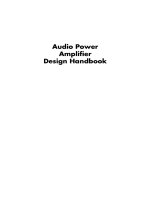
![audio power amplifier design handbook [electronic resource]](https://media.store123doc.com/images/document/14/y/jj/medium_jjd1401348061.jpg)
